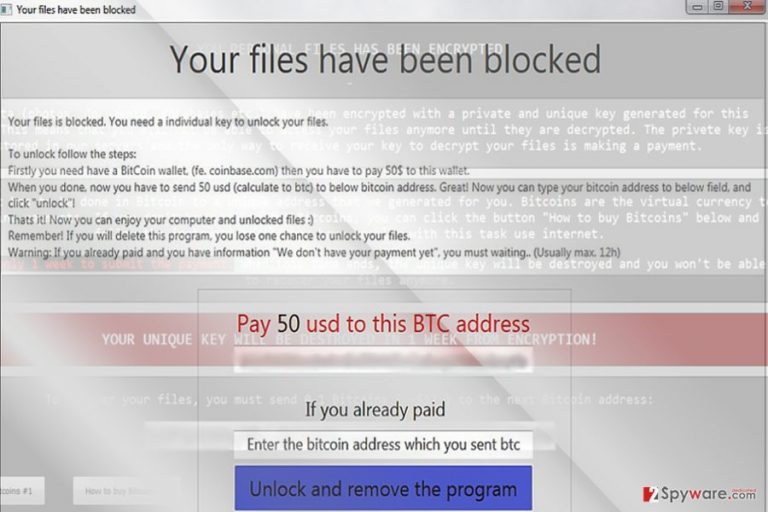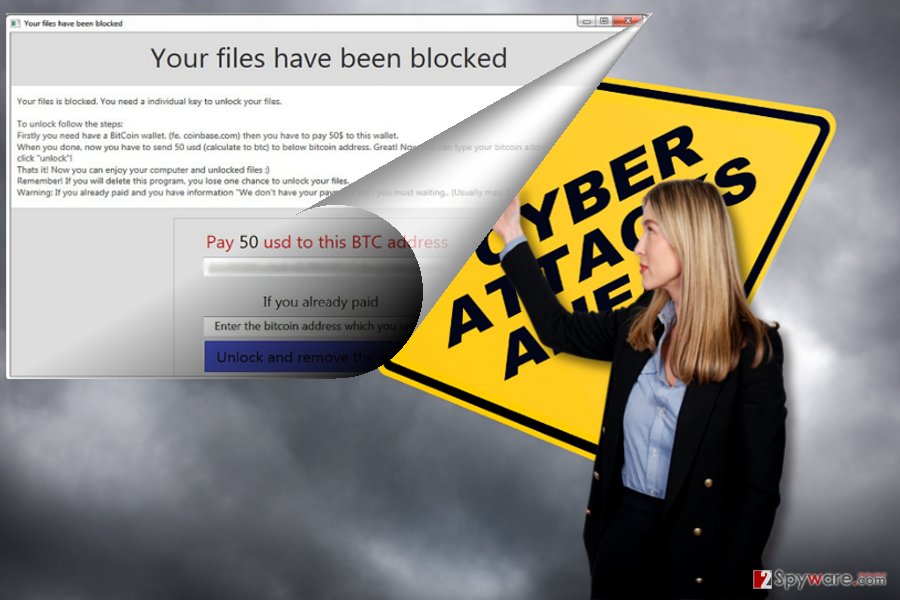“Your Files Have Been Blocked” ransomware / virus (Tutorial) - Free Instructions
“Your Files Have Been Blocked” virus Removal Guide
What is “Your Files Have Been Blocked” ransomware virus?
Kamil ransomware starts its second round of attack
“Your files have been blocked” virus, alternatively labeled as Kamil malware, functions as a file-encrypting threat. Its first signs have been already detected on May 29, 2017.[1] Due to the lack of analysis, its genealogy was unknown at the beginning, but now the malware shows more signs similar to Crypren virus. Similar to the former virus, the current version requires 50 dollars in exchange to the files. The ransom note instructs affected netizens to create a bitcoin wallet, purchase bitcoins of necessary value and then transfer them to the specified address. Furthermore, it also appends certain file extension – .lock – to affected files. The perpetrators warn not to delete the software as it may lead to irreversible loss of the files. It is a common strategy to scare victims, so we suggest you not to waste energy, but instead, save it for “Your files have been blocked” removal. For that purpose, you may use FortectIntego or Malwarebytes.
Though the malware is already out in the wild for a week already, in the beginning, it presented quite a riddle for IT specialists. Fortunately, it is already detectable by a number of anti-virus tools. Further analysis reveals that it might have elements of HiddenTear. It explains the fact why “Your files have been blocked” malware is decryptable even though the process takes a couple of hours. If you are wondering how the malware managed to break into your PC, you may have accelerated Kamil hijack by opening a corrupted spam email attachment. Then, it connects to Command and Control server to download the remaining part of the ransomware payload. You may not notice any of its signs except slower PC processes. On the one hand, it is fortunate that the virus leaves its distinctive mark – .lock file extensions. This fact lets users detect the malware sooner. In contrast to the ransom note instructions, we do not recommend remitting the payment to unlock the files. The message notes that payment confirmation takes up 12 hours. However, no one gives guarantees that the payment procedure is processed successfully. Remove “Your files have been blocked” virus rather than foster naïve hopes. 
Ransomware distribution channels
Kamil malware is suspected of spreading through two transmission ways: spam emails[2] and trojans. Elaborating on the former method, it disguises under important.exe. Therefore, it might be delivered along with a supposed tax report or invoice notification. Alternatively, you may be asked to review further details about an undelivered email or parcel. Do not fall for such common bait. Inspect carefully the email for any ransomware hints: grammar mistakes or typos. Only when you are sure of the sender’s identity, open the attached documents. Note that “Your files have been blocked” malware functions via Trojan-Ransom.Win32.Crypren.adsz, Trojan-Ransom.Filecoder (A), or Win32.Trojan.Crypren.Ljuj. Ensure your PC protection with cyber security software. The firewall may be of use as well.
Options to eradicate “Your files have been blocked” ransomware
Regardless whether the malware is poorly coded or possesses a highly exquisite structure, manual elimination option is never an option. It also applies to “Your files have been blocked” removal process. Launch an anti-spyware app. Update it for the program to detect and eliminate all elements and malware registry keys. In case you cannot remove “Your files have been blocked” virus from the first attempt, below guidelines contain valuable tips how to gain access to key system functions and then finish the termination process. Check bonus recovery instructions at the bottom of the page as well.
Getting rid of “Your Files Have Been Blocked” virus. Follow these steps
Manual removal using Safe Mode
Safe Mode is especially practical if ransomware meddles with the PC functions. Though this method grants only limit control of the device, you may succeed eliminating “Your files have been blocked” malware.
Important! →
Manual removal guide might be too complicated for regular computer users. It requires advanced IT knowledge to be performed correctly (if vital system files are removed or damaged, it might result in full Windows compromise), and it also might take hours to complete. Therefore, we highly advise using the automatic method provided above instead.
Step 1. Access Safe Mode with Networking
Manual malware removal should be best performed in the Safe Mode environment.
Windows 7 / Vista / XP
- Click Start > Shutdown > Restart > OK.
- When your computer becomes active, start pressing F8 button (if that does not work, try F2, F12, Del, etc. – it all depends on your motherboard model) multiple times until you see the Advanced Boot Options window.
- Select Safe Mode with Networking from the list.

Windows 10 / Windows 8
- Right-click on Start button and select Settings.

- Scroll down to pick Update & Security.

- On the left side of the window, pick Recovery.
- Now scroll down to find Advanced Startup section.
- Click Restart now.

- Select Troubleshoot.

- Go to Advanced options.

- Select Startup Settings.

- Press Restart.
- Now press 5 or click 5) Enable Safe Mode with Networking.

Step 2. Shut down suspicious processes
Windows Task Manager is a useful tool that shows all the processes running in the background. If malware is running a process, you need to shut it down:
- Press Ctrl + Shift + Esc on your keyboard to open Windows Task Manager.
- Click on More details.

- Scroll down to Background processes section, and look for anything suspicious.
- Right-click and select Open file location.

- Go back to the process, right-click and pick End Task.

- Delete the contents of the malicious folder.
Step 3. Check program Startup
- Press Ctrl + Shift + Esc on your keyboard to open Windows Task Manager.
- Go to Startup tab.
- Right-click on the suspicious program and pick Disable.

Step 4. Delete virus files
Malware-related files can be found in various places within your computer. Here are instructions that could help you find them:
- Type in Disk Cleanup in Windows search and press Enter.

- Select the drive you want to clean (C: is your main drive by default and is likely to be the one that has malicious files in).
- Scroll through the Files to delete list and select the following:
Temporary Internet Files
Downloads
Recycle Bin
Temporary files - Pick Clean up system files.

- You can also look for other malicious files hidden in the following folders (type these entries in Windows Search and press Enter):
%AppData%
%LocalAppData%
%ProgramData%
%WinDir%
After you are finished, reboot the PC in normal mode.
Remove “Your Files Have Been Blocked” using System Restore
-
Step 1: Reboot your computer to Safe Mode with Command Prompt
Windows 7 / Vista / XP- Click Start → Shutdown → Restart → OK.
- When your computer becomes active, start pressing F8 multiple times until you see the Advanced Boot Options window.
-
Select Command Prompt from the list

Windows 10 / Windows 8- Press the Power button at the Windows login screen. Now press and hold Shift, which is on your keyboard, and click Restart..
- Now select Troubleshoot → Advanced options → Startup Settings and finally press Restart.
-
Once your computer becomes active, select Enable Safe Mode with Command Prompt in Startup Settings window.

-
Step 2: Restore your system files and settings
-
Once the Command Prompt window shows up, enter cd restore and click Enter.

-
Now type rstrui.exe and press Enter again..

-
When a new window shows up, click Next and select your restore point that is prior the infiltration of “Your Files Have Been Blocked”. After doing that, click Next.


-
Now click Yes to start system restore.

-
Once the Command Prompt window shows up, enter cd restore and click Enter.
Bonus: Recover your data
Guide which is presented above is supposed to help you remove “Your Files Have Been Blocked” from your computer. To recover your encrypted files, we recommend using a detailed guide prepared by 2-spyware.com security experts.If your files are encrypted by “Your Files Have Been Blocked”, you can use several methods to restore them:
Opting for Data Recovery Pro
If you did not make extra copies, this program may help you restore encoded valuable documents.
- Download Data Recovery Pro;
- Follow the steps of Data Recovery Setup and install the program on your computer;
- Launch it and scan your computer for files encrypted by “Your Files Have Been Blocked” ransomware;
- Restore them.
The pros of Shadow Explorer software
if you have run out of options, try this software. It employs volume shadow copies to restore volumes. Since there is no information that Kamil virus deletes them in, you may stand a chance.
- Download Shadow Explorer (http://shadowexplorer.com/);
- Follow a Shadow Explorer Setup Wizard and install this application on your computer;
- Launch the program and go through the drop down menu on the top left corner to select the disk of your encrypted data. Check what folders are there;
- Right-click on the folder you want to restore and select “Export”. You can also select where you want it to be stored.
“Your files have been blocked” Decrypter
Though the malware seems to be decryptable, be patient until the free tool is released. Avoid installing the decryption app offered by hackers. Even it decrypts files, it may facilitate future ransomware infiltration.
Finally, you should always think about the protection of crypto-ransomwares. In order to protect your computer from “Your Files Have Been Blocked” and other ransomwares, use a reputable anti-spyware, such as FortectIntego, SpyHunter 5Combo Cleaner or Malwarebytes
How to prevent from getting ransomware
Protect your privacy – employ a VPN
There are several ways how to make your online time more private – you can access an incognito tab. However, there is no secret that even in this mode, you are tracked for advertising purposes. There is a way to add an extra layer of protection and create a completely anonymous web browsing practice with the help of Private Internet Access VPN. This software reroutes traffic through different servers, thus leaving your IP address and geolocation in disguise. Besides, it is based on a strict no-log policy, meaning that no data will be recorded, leaked, and available for both first and third parties. The combination of a secure web browser and Private Internet Access VPN will let you browse the Internet without a feeling of being spied or targeted by criminals.
No backups? No problem. Use a data recovery tool
If you wonder how data loss can occur, you should not look any further for answers – human errors, malware attacks, hardware failures, power cuts, natural disasters, or even simple negligence. In some cases, lost files are extremely important, and many straight out panic when such an unfortunate course of events happen. Due to this, you should always ensure that you prepare proper data backups on a regular basis.
If you were caught by surprise and did not have any backups to restore your files from, not everything is lost. Data Recovery Pro is one of the leading file recovery solutions you can find on the market – it is likely to restore even lost emails or data located on an external device.
- ^ Andrew Ivanov. Kamil ransomware. Ransomware Identification Blog.
- ^ Bradley Barth. Researchers observe 'aggressive' spam campaign selling Philadelphia ransomware. SCMedia. The cyber security source.







